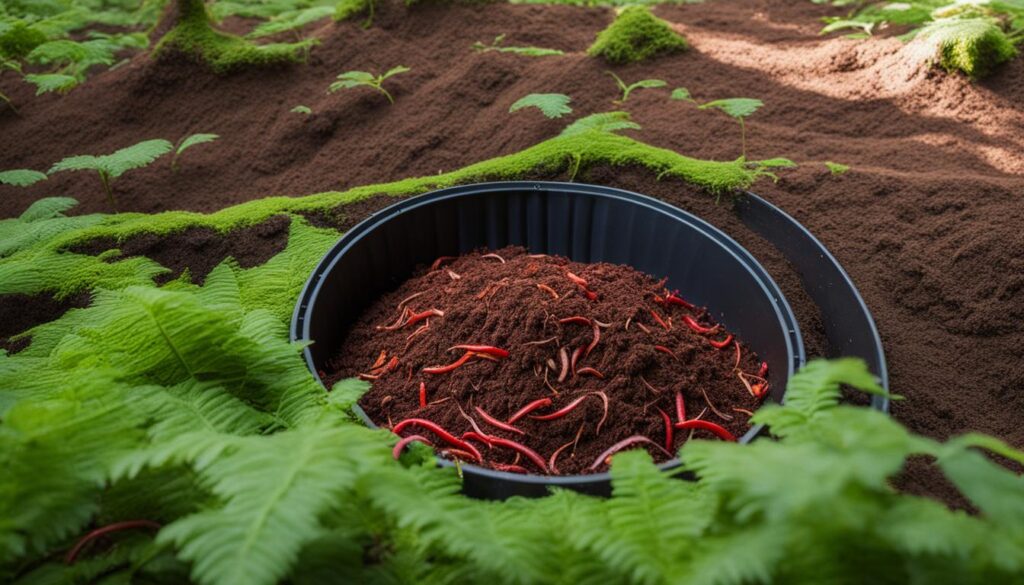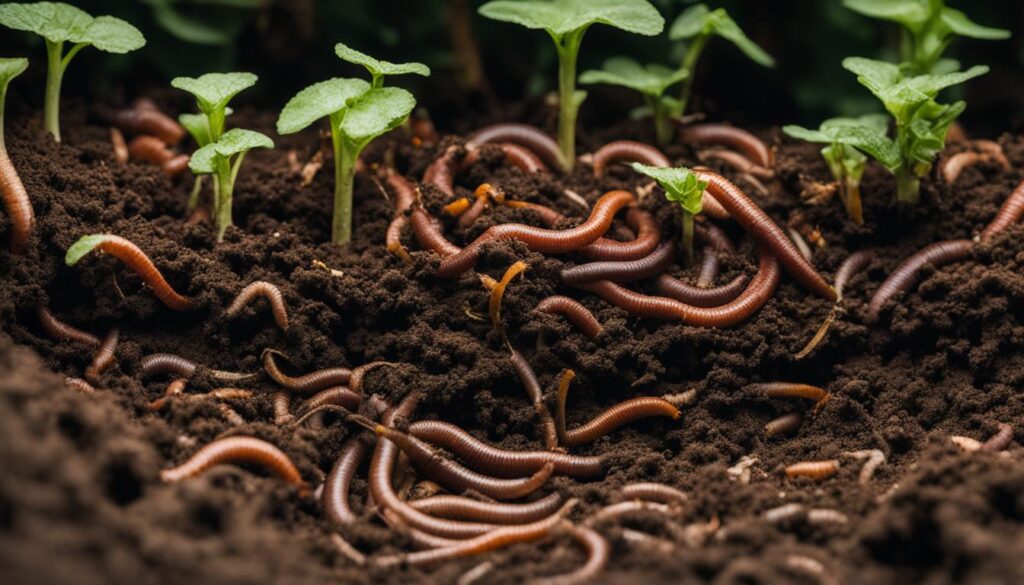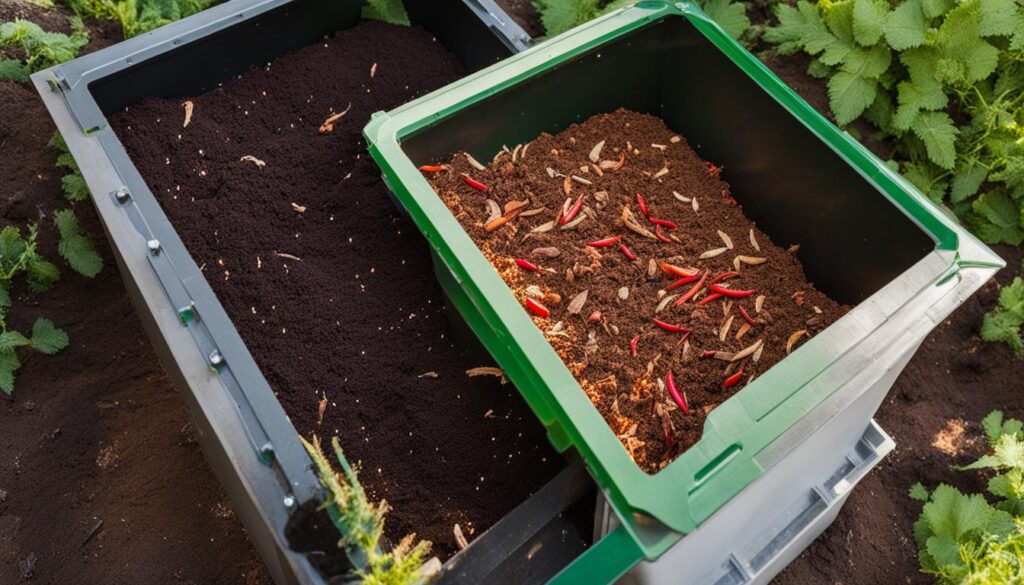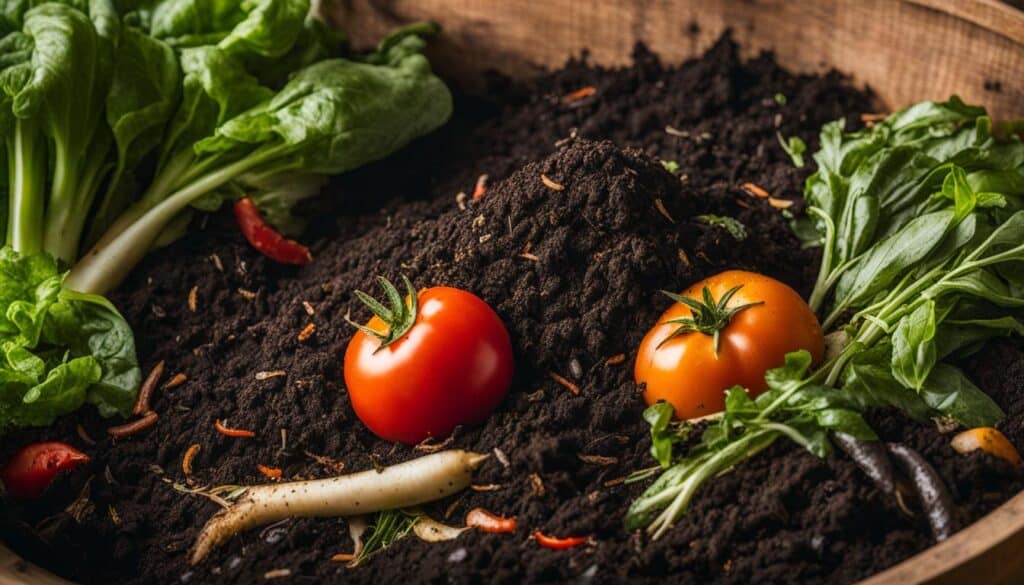Welcome to my guide on vermicomposting vs composting. In this article, I will provide you with all the information you need to know about these two methods of organic waste management. Whether you are a seasoned gardener or a beginner, understanding the differences between vermicomposting and composting can help you make an informed decision for your gardening needs.
Composting is a well-known method of recycling organic waste materials, such as kitchen scraps, yard waste, and plant debris, to create nutrient-rich compost. It involves the natural decomposition of these materials through the actions of bacteria, fungi, and other microorganisms. Composting has been widely used for centuries and offers several benefits, including improved soil fertility and enhanced plant growth.
On the other hand, vermicomposting takes composting to a whole new level by introducing our wriggly friends, the worms! Vermicomposting is the process of using worms, specifically species like Eisenia foetida and Lumbricus rubellis, to break down organic waste and produce vermicompost, also known as worm castings or worm manure.
Vermicomposting offers unique advantages over traditional composting methods. Firstly, the worms accelerate the decomposition process by consuming the organic waste, breaking it down into nutrient-rich worm castings. This process, known as vermiculture, results in a highly concentrated and beneficial soil amendment.
Gardening with compost, whether it’s traditional compost or vermicompost, can greatly enhance your soil’s fertility. Compost improves soil structure, increases moisture retention, and provides essential nutrients for plant growth. It also promotes the growth of beneficial soil microorganisms, which contribute to the overall health of your garden.
Choosing between vermicomposting and composting depends on various factors, including the type and quantity of organic waste you have, the space available for composting, and your specific gardening goals. Both methods are environmentally sustainable and contribute to reducing waste and promoting a greener lifestyle.
In the following sections of this guide, I will delve deeper into the vermicomposting process, types of worms used, environmental requirements, feed materials, maintaining a vermicomposting system, cohabitant organisms, the concept of in-bed vermicomposting, and how to harvest vermicompost and worms. Stay tuned!
And after reading this article, check out our blog post on: Different Types Of Compost To Enrich Your Soil
What is Vermicompost?
Vermicompost, also known as worm manure or castings, is the end product of vermicomposting. It is a nutrient-rich soil amendment that provides essential nutrients for plant growth. The nutrient content of vermicompost depends on the materials fed to the worms, such as food waste and manures. Worm castings contain a variety of nutrients that are readily available for plant uptake. The biology of the worm’s gut promotes the growth of beneficial fungi and bacteria that enhance plant growth. Vermicompost also contains chemical compounds that are believed to promote plant growth. It is a valuable fertilizer for gardens and helps improve soil fertility.
Benefits of Vermicompost
- Enhances soil fertility: The nutrient-rich composition of vermicompost improves soil structure and provides essential nutrients for plant growth.
- Promotes plant growth: The beneficial microorganisms and chemical compounds in vermicompost stimulate root development and enhance overall plant growth.
- Improves soil water retention: Vermicompost improves the water-holding capacity of soil, reducing the need for frequent watering and helping plants withstand drought conditions.
- Suppresses plant diseases: The presence of beneficial microorganisms in vermicompost helps suppress harmful pathogens, reducing the risk of plant diseases.
- Environmentally friendly: Vermicomposting is a sustainable method of organic waste management, reducing the volume of waste sent to landfills and promoting environmental sustainability.
Using Vermicompost as Fertilizer
Vermicompost can be used as a natural and organic fertilizer in gardens, lawns, houseplants, and agricultural fields. It can be applied directly to the soil or mixed with potting soil for container gardening. The nutrient content of vermicompost varies, but it typically contains beneficial elements such as nitrogen, phosphorus, potassium, calcium, magnesium, and trace minerals. These nutrients are released slowly and are readily available to plants. The use of vermicompost as a fertilizer can improve plant health, increase crop yields, and result in more vibrant and productive gardens.
Read This More Information Composting Methods: Exploring The Best Plants for Hugelkultur Beds
Types of Worms Used in Vermicomposting
When it comes to vermicomposting, there are several types of worms that are commonly used. Two of the most popular species are Eisenia foetida and Lumbricus rubellis, also known as red worms, red wigglers, tiger worms, brandling worms, and manure worms. These worms are specifically raised for their ability to produce high-quality vermicompost. While there are other species of worms that can be used in vermicomposting, this guide focuses on the use of Eisenia foetida and Lumbricus rubellis.
Red worms and their various aliases thrive in the vermicomposting environment. They are difficult to distinguish from one another and are known for their efficiency in converting organic waste into nutrient-rich castings. These worms are well-suited for the temperature range typically found in vermicomposting systems, which is between 55 and 77 degrees Fahrenheit. They also require a moist, organic substrate for bedding, providing them with the ideal conditions for feeding and reproducing.
The use of red worms in vermicomposting has gained popularity due to their voracious appetite and ability to consume a wide range of organic materials. These worms can efficiently process food waste, manure, and yard waste, turning it into valuable vermicompost. They are an essential component of the vermicomposting ecosystem, breaking down organic matter and contributing to the overall sustainability of the process.
Benefits of Using Red Worms in Vermicomposting
“Red worms are the workhorses of the vermicomposting world. They quickly process organic waste and produce nutrient-rich castings that can enhance soil fertility and promote plant growth.”
Using red worms in vermicomposting offers several benefits. Firstly, these worms are highly efficient at consuming and breaking down organic waste, making the vermicomposting process faster and more effective. Their ability to process a variety of organic materials, such as food waste and yard waste, also makes them a versatile choice for vermicomposting systems.
Furthermore, red worms produce castings that are rich in nutrients, beneficial microorganisms, and organic matter. These castings, also known as vermicompost, are an excellent soil amendment that can improve soil fertility and provide essential nutrients for plant growth. Vermicompost has been shown to enhance plant productivity, root development, and overall plant health.
In addition to their efficiency and nutrient-rich castings, red worms are relatively easy to maintain. They are resilient and can adapt to various environmental conditions. With proper care and management, red worms can thrive in vermicomposting systems, providing gardeners with a sustainable and effective means of managing organic waste and improving soil health.
Environmental Requirements for Vermicomposting
In order for vermicomposting to be successful, it is important to provide the worms with the right environmental conditions. This includes maintaining optimal temperature, moisture levels, organic substrate, bedding, and pH level.
Temperature
The ideal temperature range for vermicomposting is between 55 and 77 degrees Fahrenheit (13-25°C). Worms thrive in this temperature range and are most active in the 59 to 68 degrees Fahrenheit (15-20°C) range. Extreme temperatures can be harmful to the worms, so it is important to monitor and regulate the temperature in the vermicomposting system.
Moisture
Worms require a moist environment to survive and thrive. The bedding material should be as damp as a wrung-out sponge. If it is too wet, it can lead to anaerobic conditions and the growth of harmful bacteria. If it is too dry, the worms may become dehydrated. Regularly monitoring and adjusting the moisture content is essential for the health of the worms and the decomposition process.
Organic Substrate and Bedding
Worms need a suitable bedding material to live in and feed on. The bedding provides a habitat for the worms and helps maintain moisture levels. Common bedding materials include shredded newspaper, cardboard, coconut coir, and leaf mulch. The bedding should be free from chemicals and contaminants and should be prepared by soaking and fluffing it up.
pH Level
Worms prefer a slightly acidic pH level of about 6.5. This pH level aids in the decomposition process and promotes the growth of beneficial microorganisms. Testing the pH level of the vermicomposting system and making adjustments, if necessary, can help create the optimal conditions for the worms.
By ensuring the proper temperature, moisture levels, organic substrate, bedding, and pH level, gardeners can create an ideal environment for vermicomposting. This will not only promote the health and productivity of the worms but also contribute to the decomposition process and the production of nutrient-rich vermicompost.

| Requirements | Optimal Range | Importance |
|---|---|---|
| Temperature | 55-77°F (13-25°C) | Worms thrive within this range; extreme temperatures can be harmful |
| Moisture | Bedding as damp as a wrung-out sponge | Provides a suitable habitat for worms and aids in decomposition |
| Organic Substrate and Bedding | Shredded newspaper, cardboard, coconut coir, leaf mulch | Creates a habitat for worms and helps maintain moisture levels |
| pH Level | Slightly acidic, around 6.5 | Aids in decomposition and promotes growth of beneficial microorganisms |
Feed Materials for Vermicomposting
Vermicomposting relies on the consumption of organic materials by worms to produce nutrient-rich vermicompost. These worms have a voracious appetite and can consume a wide variety of organic waste, making vermicomposting an excellent solution for reducing food waste and managing other organic materials.
Here are some common feed materials that can be used for vermicomposting:
- Food waste: Leftover fruits and vegetables, coffee grounds, tea leaves, and crushed eggshells are all excellent food sources for worms.
- Manure: Animal manure, such as from cows, horses, or chickens, can be used as a nutrient-rich feed material. However, it is essential to use fully composted manure to avoid introducing harmful pathogens into the vermicomposting system.
- Yard waste: Grass clippings, leaves, and small prunings can all be used as feed materials. However, avoid using large branches or woody materials, as worms are unable to consume them effectively.
- Coffee grounds: Coffee grounds are a popular feed material for worms due to their high nitrogen content. They can be mixed with other organic materials to create a balanced diet for the worms.
- Citrus scraps: While worms can consume limited amounts of citrus scraps, it is best to limit or avoid feeding them this material. The chemical compound found in citrus, limonene, is toxic to worms.
By feeding worms a diverse range of organic materials, gardeners can ensure that they receive a balanced diet and produce high-quality vermicompost. It is important to monitor the moisture levels in the vermicomposting system and adjust the feeding accordingly. Too much moisture can lead to anaerobic conditions, while too little moisture can hinder the worms’ activity.
| Organic Material | Benefits | Considerations |
|---|---|---|
| Food waste | Provides essential nutrients for worms | Avoid oily foods, meat, and dairy products |
| Manure | High in nutrients and beneficial microorganisms | Use fully composted manure |
| Yard waste | Source of carbon and nutrients | Avoid large branches and woody materials |
| Coffee grounds | High in nitrogen and beneficial for soil | Mix with other organic materials for a balanced diet |
| Citrus scraps | Can be consumed in limited amounts | Limonene compound is toxic to worms |
Remember to avoid adding materials that are harmful to worms, such as pesticides, chemicals, and non-organic waste. Regular monitoring of the vermicomposting system and adjustment of the feeding will ensure healthy worm activity and the production of nutrient-rich vermicompost.
Maintaining a Vermicomposting System
When it comes to maintaining a vermicomposting system, there are a few key factors to consider. Whether you are using a worm bin, a worm bed, or an in-vessel continuous-flow system, proper management is crucial for the health and productivity of your worms and the quality of the vermicompost produced.
In terms of the physical setup, ensure that your worm habitat provides enough space for the worms to thrive. Whether it’s a small-scale bin or a larger bed, make sure it is placed in a suitable location that meets the environmental requirements discussed earlier. A dark environment, a slightly acidic pH level, and a moist, organic substrate or bedding are all essential for the worms’ well-being.
Regular maintenance tasks include feeding the worms a balanced diet of organic materials, monitoring the moisture levels, and ensuring the temperature stays within the preferred range. Additionally, periodically harvesting the vermicompost is necessary to maintain the system’s productivity. This can be done by dumping the bin onto a tarp and separating the castings or gradually moving the worms to a new bedding area.
Table: Common Maintenance Tasks for Vermicomposting Systems
| Maintenance Tasks | Description |
|---|---|
| Feeding the worms | Provide a balanced diet of organic materials such as food waste, manure, and yard waste to sustain the worms’ health and promote vermicompost production. |
| Monitoring moisture levels | Ensure the bedding remains as damp as a wrung-out sponge to maintain the worms’ habitat and facilitate their digestion process. |
| Temperature control | Monitor the temperature within the preferred range of 55 to 77 degrees Fahrenheit to ensure optimal worm activity and reproduction. |
| Harvesting the vermicompost | Remove mature vermicompost from the system, either by separating it from the worms or moving the worms to a new bedding area. |
| Regular monitoring | Check the overall health of the worms, look out for any signs of pests or disease, and adjust the environmental conditions as needed. |
Remember, curing the harvested castings before use is important. This process allows any remaining food scraps or bedding materials to break down further, resulting in a more stable and nutrient-rich vermicompost. Curing can be done in an aerobic environment for a few weeks before incorporating the vermicompost into your garden soil or using it as a potting mix for indoor plants.
By following these maintenance guidelines, you can ensure the long-term success of your vermicomposting system and enjoy the benefits of nutrient-rich vermicompost for your garden.
Worms and Their Environment
When it comes to vermicomposting, worms do not live in isolation. They share their environment with various other organisms, some of which can be considered cohabitants. These cohabitants can include microscopic organisms like bacteria and fungi, as well as other creatures like springtails, mites, pot worms, fungus gnats, ants, fruit flies, and even larger animals like birds and moles. Most of these organisms live in harmony with the worms and contribute positively to the vermicomposting process. However, some pests, such as ants and fruit flies, can become troublesome in a worm bin.
Springtails, mites, and pot worms are commonly found in worm bins and help break down organic matter. They play a vital role in the decomposition process and contribute to the overall health of the vermicomposting system. Fungus gnats, on the other hand, can be a nuisance as they lay their eggs in the moist organic matter. Ants and fruit flies are attracted to the food waste in the worm bin and can quickly become a problem if left unmanaged.
To minimize the presence of pests, it is important to practice proper management techniques. Burying food waste in the bedding and periodically stirring the contents of the bin can help discourage unwanted pests. Maintaining a well-balanced and efficient vermicomposting system will create an environment that is less attractive to pests. While outdoor worm bins may attract more organisms, taking precautions to prevent unwanted animals from entering the bins can help maintain a healthy vermicomposting environment.

| Cohabitant Organism | Nature | Role in Vermicomposting |
|---|---|---|
| Springtails | Microscopic organisms | Contribute to the decomposition process |
| Mites | Microscopic organisms | Aid in breaking down organic matter |
| Pot worms | Small worms | Contribute to the overall health of the vermicomposting system |
| Fungus gnats | Small flies | Lay eggs in moist organic matter |
| Ants | Insects | Attracted to food waste in the worm bin |
| Fruit flies | Insects | Attracted to food waste in the worm bin |
By understanding the cohabitants in a vermicomposting system and implementing proper management techniques, gardeners can maintain a healthy and productive environment for their worms. This will help ensure the successful decomposition of organic matter and the production of nutrient-rich vermicompost.
In-Bed Vermicomposting
In-bed vermicomposting is a unique method that allows worms to live and work directly in garden beds, providing a continuous source of nutrients for plants. This approach is particularly beneficial in hot weather conditions, as the worms can burrow deeper into the soil to escape the intense heat. By integrating worm habitats into garden beds, gardeners can create a self-sustaining system that promotes healthy soil and plant growth.
Worms in garden beds play a vital role in breaking down organic matter, such as food scraps and plant waste, into nutrient-rich vermicompost. They also help to aerate the soil and improve its structure. The presence of worms in the garden bed creates a natural ecosystem where beneficial microorganisms thrive, promoting overall soil health.
Feeding the worms in a in-bed vermicomposting system is essential for their well-being and productivity. Organic materials such as kitchen scraps, fruit waste, and coffee grounds can be added to the bed to provide a balanced diet for the worms. It is important to avoid overfeeding and ensure the organic matter is properly incorporated into the soil to prevent odor and pest issues.
| Benefits of In-Bed Vermicomposting |
|---|
| Continuous nutrient supply for plants |
| Improvement of soil structure and fertility |
| Natural ecosystem promotion |
| Reduction of organic waste sent to landfills |
| Enhanced soil aeration and water retention |
In-bed vermicomposting is a sustainable and efficient method for gardeners to manage organic waste and improve soil health. By integrating worms into garden beds, gardeners can create a thriving ecosystem that promotes plant growth and reduces the need for chemical fertilizers. This method is particularly useful in hot weather conditions, where worms can seek refuge in the cooler depths of the soil. Feeding the worms a balanced diet of organic materials ensures their health and productivity, leading to the production of nutrient-rich vermicompost. In-bed vermicomposting is a win-win for both gardeners and the environment.
Setting Up an In-Bed Vermicomposting System
When it comes to setting up an in-bed vermicomposting system, there are a few key steps to follow. First, you’ll need to choose a suitable vermicomposting bin that provides enough space for the worms to thrive. Consider the size of your garden and the amount of organic waste you generate to determine the appropriate bin size. It’s important to place the bin in a hole dug in the garden bed, ensuring that it is level and secure.
Once you have your bin in place, it’s time to add the worms. Red wigglers, also known as Eisenia foetida, are a popular choice for vermicomposting. These worms are well-suited to the vermicomposting environment and can efficiently convert organic waste into nutrient-rich vermicompost. You can purchase red wigglers from a reputable supplier or ask fellow gardeners for a starter population.
Next, you’ll need to create the right conditions for the worms to thrive. Temperature is an important factor to consider, as worms prefer a range of 55 to 77 degrees Fahrenheit. It’s also crucial to maintain a moist environment, as worms require a damp bedding material to survive. Shredded cardboard is a common choice for bedding, and it should be wetted down to a moist consistency, similar to a wrung-out sponge.
Feeding your worms a balanced diet is essential for their health and productivity. While they can consume a variety of organic materials, it’s important to avoid certain items like meat, dairy products, and oily foods. Kitchen scraps, fruit waste, and other organic materials make suitable food sources for the worms. It’s best to cut or blend the food into small pieces to make it easier for the worms to consume.
By following these steps and providing the right conditions for your worms, you can set up an in-bed vermicomposting system that will efficiently transform your organic waste into valuable vermicompost.

Harvesting Vermicompost and Worms
In order to make the most of your vermicomposting system, it’s important to know how to properly harvest the vermicompost and separate the worms. There are several methods that can be used, depending on the scale of your vermicomposting system. Large-scale worm farmers often use specialized harvesting equipment to separate the worms and castings efficiently. However, for smaller-scale systems, there are simpler methods that can be employed.
One common method is to dump the contents of your worm bin onto a tarp or a large plastic sheet. Allow the worms to naturally migrate downward towards the bottom of the pile, as they do not like exposure to light. After a short period of time, you can then scrape off the top layer of material, which will contain mostly worm-free castings. Repeat this process a few times, gradually removing the castings while leaving the worms behind.
Another method, known as the “reverse harvest,” involves creating a new bedding area in your vermicomposting system and moving the worms into it. Start by filling a container with fresh bedding material and adding some food scraps to attract the worms. Place this container on top of your existing vermicomposting system and cover it with a moist burlap sack or a piece of cardboard. The worms will migrate towards the new food source, allowing you to easily separate them from the castings.
| Harvesting Methods | Advantages | Disadvantages |
|---|---|---|
| Dumping the bin onto a tarp | Simple and cost-effective | Can be time-consuming for larger systems |
| “Reverse harvest” technique | Allows for easy separation of worms and castings | Requires setting up a new bedding area |
| Harvesting equipment | Efficient and time-saving for large-scale operations | Can be expensive to purchase or rent |
Once you have harvested your vermicompost, it’s important to handle it properly. Fresh vermicompost can be quite potent and may contain undigested food scraps, worm cocoons, and eggshells. To ensure a high-quality product, it is recommended to cure the vermicompost before using it. Curing involves allowing the vermicompost to sit in a well-ventilated area for a period of time, typically a few weeks to a few months. During this time, the vermicompost will stabilize and mature, resulting in a more uniform and balanced fertilizer.
When storing vermicompost, it’s important to keep it in a dry and cool place, away from direct sunlight. This will help prevent the growth of mold or the attraction of pests. Additionally, it’s a good idea to periodically check the moisture content of your stored vermicompost and add water if necessary to maintain the ideal moisture level. Proper storage and curing will help ensure that your vermicompost remains in optimal condition until you are ready to use it in your garden.
Conclusion
Vermicomposting offers a multitude of benefits for gardeners, making it a popular choice for organic waste management and soil fertility enhancement. The process of vermicomposting involves using worms to convert organic waste into nutrient-rich vermicompost, which serves as a valuable soil amendment for promoting plant growth.
When comparing vermicomposting to traditional composting, gardeners need to consider their specific needs and the desired end products. While both methods can effectively transform organic waste into compost, vermicomposting offers unique advantages. It allows for the production of high-quality vermicompost with a diverse range of beneficial nutrients that are readily available for plant uptake.
Choosing between vermicomposting and traditional composting ultimately depends on the gardener’s preferences and the specific requirements of their garden. Vermicomposting is a sustainable and environmentally friendly option that allows gardeners to actively participate in organic waste management while improving the health and productivity of their plants. It is a gardener’s choice that offers numerous benefits for both the garden and the environment.


